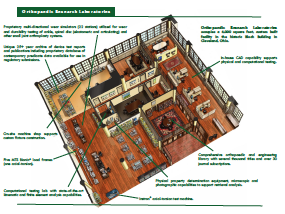Standards Testing

Standards Testing - Hip
For more than four decades, ORL is recognized as an innovator of testing standards and methods with an extensive track record of providing information necessary for successful regulatory approvals, product quality confirmation, marketing materials and surgeon education. This Standards listing encapsulates the breadth of this expertise.
ASTM F543 - Standard Specification and Test Methods for Metallic Medical Bone Screws
This test method is used to measure the torsional yield strength, maximum torque, and breaking angle of the bone screw under standard conditions.
ASTM F1714 - Standard Guide for Gravimetric Wear Assessment of Prosthetic Hip Designs in Simulator Devices
This guide uses a weight-loss method of wear determination for the polymeric components used with hip joint prostheses, using serum or demonstrated equivalent fluid for lubrication, and running under a dynamic load profile representative of the human hip-joint forces during walking.
ASTM F1814 - Standard Guide for Evaluating Modular Hip and Knee Joint Components
This guide assists the developer of a modular joint replacement implant in the choice of appropriate tests and evaluations to determine device safety.
ASTM F1820 - Standard Test Method for Determining the Forces for Disassembly of Modular Acetabular Devices
This test method is a standard methodology by which to measure the attachment strength between the modular acetabular shell and liner (i.e., locking mechanism integrity).
ASTM F2068 - Standard Specification for Femoral Prostheses—Metallic Implants
This specification covers metallic stemmed femoral prostheses used to replace the natural hip joint by means of hemi-arthroplasty or total hip surgical procedures. The mechanical strength, corrosion resistance, and biocompatibility of the head portions of one-piece integral implants are covered by this specification.
ASTM F2091 - Standard Specification for Acetabular Prostheses
This specification is intended to provide basic descriptions of materials and device geometry of acetabular resurfacing devices used to provide a functioning articulation between the bones of the acetabulum and the femur. Additionally, those characteristics determined to be important toin vivoperformance of the prosthesis are defined.
ASTM F2345 - Standard Test Methods for Determination of Static and Cyclic Fatigue Strength of Ceramic Modular Femoral Heads
These test methods cover the evaluation of the static and cyclic fatigue strength of ceramic modular femoral heads utilized in total hip arthroplasty.
ASTM F2580 - Standard Practice for Evaluation of Modular Connection of Proximally Fixed Femoral Hip Prosthesis
This practice covers a procedure for the fatigue testing of metallic femoral hip prostheses used in hip joint replacements that utilize proximal metaphyseal fixation and are of a modular construct.
ASTM F2582 - Standard Test Method for Impingement of Acetabular Prostheses
This test method covers a procedure to evaluate acetabular component fatigue, deformation, and wear and femoral head assembly dislocation under dynamic impingement conditions.
ASTM F2979 - Standard Guide for Characterization of Wear from the Articulating Surfaces in Retrieved Metal-on-Metal and other Hard-on-Hard Hip Prostheses
This guide specifies a method to measure the in-vivo wear of explanted metal-on-metal and other hard hip components. The guide covers the measurement of acetabular cups and femoral heads using a dimensional change method and is applicable to all prosthetic hip types, including stemmed (modular) and resurfacing hip systems.
ASTM F2996 - Standard Practice for Finite Element Analysis (FEA) of Non-Modular Metallic Orthopaedic Hip Femoral Stems
This practice is applicable to the calculation of stresses seen on a femoral hip stem when loaded in a manner described in ISO 7206-4 (2010). This method can be used to establish the worst-case size for a particular implant.
ASTM F3018 - Standard Guide for Assessment of Hard-on-Hard Articulation Total Hip Replacement and Hip Resurfacing Arthroplasty Devices
This document provides guidance for a range of assessments and evaluations to aid in preclinical research and device development of hard-on-hard total hip replacement and hip resurfacing devices used for the repair of musculoskeletal disorders.
ASTM 3047M - Standard Guide for High Demand Hip Simulator Wear Testing of Hard-on-hard Articulations
The objective of this guide is to advise researchers on the possible high demand wear test features that should be included in evaluation of hard on hard articulations.
ISO 7206-1 - Implants for surgery — Partial and total hip joint prostheses — Part 1: Classification and designation of dimensions
This part provides a means of classification and standardizes the designation of dimensions for partial and total hip joint prostheses.
ISO 7206-2 - Implants for surgery — Partial and total hip joint prostheses — Part 2: Articulating surfaces made of metallic, ceramic and plastics materials
This part specifies requirements for the articulating surfaces of those types of total and partial hip joint prostheses that provide a joint replacement of ball and socket configuration.
ISO 7206-4 - Implants for surgery — Partial and total hip joint prostheses — Part 4: Determination of endurance properties of stemmed femoral components
This part specifies a test method for determining the endurance properties of stemmed femoral components of total hip joint prostheses and stemmed femoral components used alone in partial hip joints.
ISO 7206-6 - Implants for surgery — Partial and total hip joint prostheses — Part 6: Determination of endurance properties of head and neck region of stemmed femoral components
This part describes test methods for determining the endurance properties of the head and neck region of stemmed femoral components of total hip joint prostheses and stemmed femoral components used alone in partial hip joint replacement.
ISO 7206-10 - Implants for surgery — Partial and total hip joint prostheses — Part 10: Determination of resistance to static load of modular femoral heads
This part applies to femoral heads of partial or total hip-joint replacements of modular construction (i.e. a head/neck conical taper connection) and describes methods of determining the load required to cause failure of the head (disassembly or fracture).
ISO 7206-12 - Implants for surgery — Partial and total hip joint prostheses — Part 12: Deformation test method for acetabular components
This part specifies a test method for determining short-term deformation of a press-fit acetabular component for total hip joint replacement.
ISO 7206-13 - Implants for surgery — Partial and total hip joint prostheses — Part 13: Determination of resistance to torque of head fixation of stemmed femoral components
This part describes a method of determining the torque required, under specified laboratory conditions, to loosen the fixation of the head of hip joint prostheses in which the head is not intended to rotate relative to the neck.
ISO 11491 - Implants for surgery — Determination of impact resistance of ceramic femoral heads for hip joint prostheses
Specifies two alternative test methods for determining the impact resistance of ceramic femoral heads for hip joint prostheses.
ISO 14242-1 - Implants for surgery — Wear of total hip-joint prostheses — Part 1: Loading and displacement parameters for wear-testing machines and corresponding environmental conditions for test
This part specifies the relative angular movement between articulating components, the pattern of the applied force, the speed and duration of testing, the sample configuration, and the test environment to be used for the wear testing of total hip joint prostheses.
ISO 14242-2 - Implants for surgery — Wear of total hip-joint prostheses — Part 2: Methods of measurement
This part specifies methods of assessment of wear of the acetabular component of total hip joint prostheses using gravimetric techniques and changes in dimensional form of components.
ISO 14242-3 - Implants for surgery — Wear of total hip-joint prostheses — Part 3: Loading and displacement parameters for orbital bearing type wear testing machines and corresponding environmental conditions for test
Specifies relative angular movement between articulating components, the pattern of the applied force, speed and duration of testing, sample configuration and test environment to be used for the orbital bearing type wear testing of total hip joint prostheses.
ISO 14242-4 - Implants for surgery — Wear of total hip-joint prostheses — Part 4: Testing hip prostheses under variations in component positioning which results in direct edge loading
This part specifies the test conditions to simulate edge loading in hip prostheses due to steep acetabular cup inclination angle and dynamic separation conditions.
ISO 17853 - Wear of implant materials — Polymer and metal wear particles — Isolation and characterization
Specifies methods for sampling wear particles generated by joint replacement implants in humans and in joint simulators.
ISO 21535 - Non-active surgical implants — Joint replacement implants — Specific requirements for hip-joint replacement implants
Provides specific requirements for hip joint replacement implants and specifies requirements for intended performance, design attributes, materials, design evaluation, manufacture, sterilization, packaging, information supplied by the manufacturer, and methods of test.

